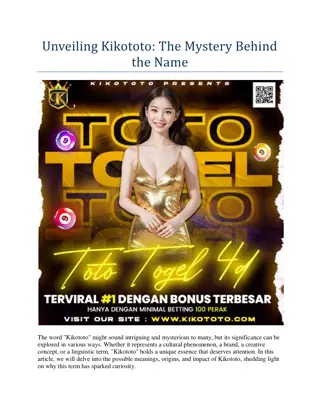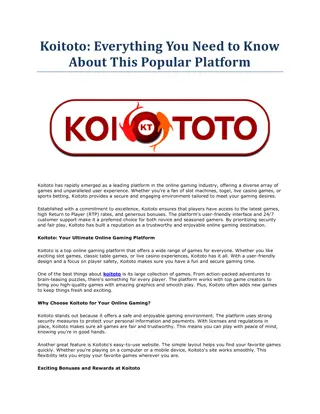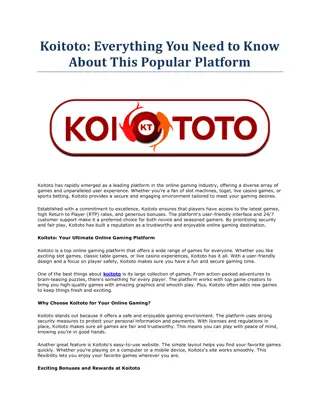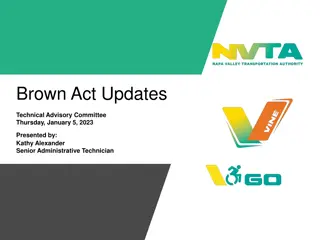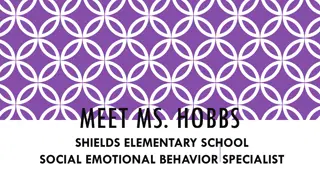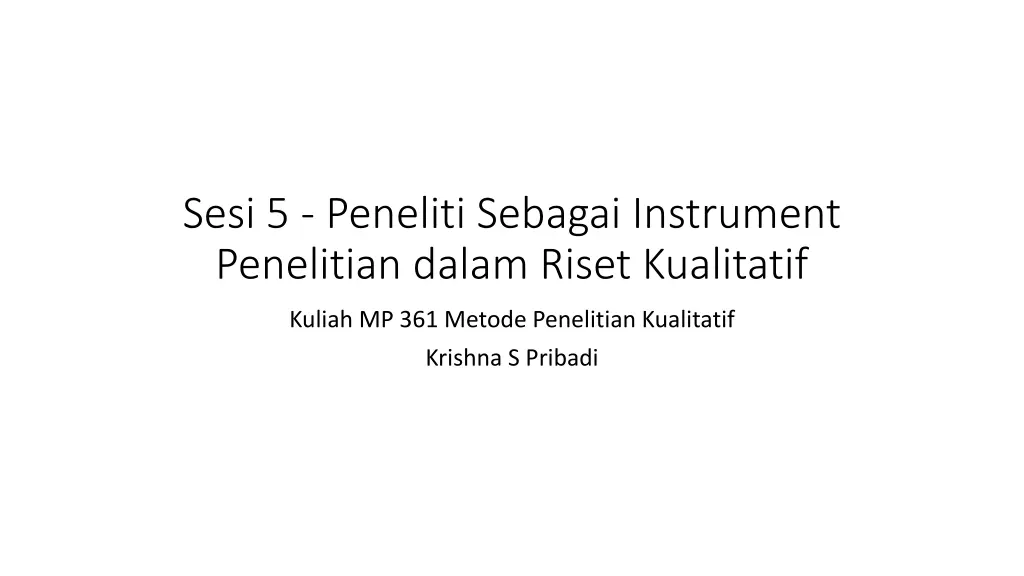
Peneliti Sebagai Instrumen Penelitian dalam Riset Kualitatif
Peneliti merupakan instrumen utama dalam pengumpulan data kualitatif, dengan sensitivitas teoritis dan karakteristik yang diperlukan untuk memahami dan mengolah data secara efektif. Mereka mampu menciptakan ruang percakapan yang aman bagi responden untuk berbagi pengalaman dan dunia kehidupan mereka.
Uploaded on | 1 Views
Download Presentation

Please find below an Image/Link to download the presentation.
The content on the website is provided AS IS for your information and personal use only. It may not be sold, licensed, or shared on other websites without obtaining consent from the author. If you encounter any issues during the download, it is possible that the publisher has removed the file from their server.
You are allowed to download the files provided on this website for personal or commercial use, subject to the condition that they are used lawfully. All files are the property of their respective owners.
The content on the website is provided AS IS for your information and personal use only. It may not be sold, licensed, or shared on other websites without obtaining consent from the author.
E N D
Presentation Transcript
Sesi 5 - Peneliti Sebagai Instrument Penelitian dalam Riset Kualitatif Kuliah MP 361 Metode Penelitian Kualitatif Krishna S Pribadi
Attributes of qualitative research One of the most fundamental and far-reaching of these attributes is that the qualitative researcher is the instrument by which data are collected. The data-gathering process in qualitative research is facilitated by interviewer or moderator guides, observation grids, and the like; however, these are only accessories to the principal data collection tool, i.e., the researcher or others on the research team.
researcher-as-instrument The phrase researcher-as-instrument refers to the researcher as an active respondent in the research process (Hammersley and Atkinson, 1995). Researchers use their sensory organs to grasp the study objects, mirroring them in their consciousness, where they then are converted into phenomenological representations to be interpreted (Turato, 2005: 510). It is through the researcher s facilitative interaction that a conversational space is created that is, an arena where respondents feel safe to share stories on their experiences and life worlds (Owens, 2006).
Researcher as instrument As the all-important tool or instrument in collecting qualitative data, the researcher embodies the definition of what it means to conduct qualitative research. It is this role that portends the rich, meaningful information we expect from qualitative research, but also signals unwanted effects that demand careful attention to research design.
Sensitivitas teoritis sebagai kualitas personal peneliti. Theoretical sensitivity refers to a personal quality of the researcher. It indicates an awareness of the subtleties of meaning of data. [It] refers to the attribute of having insight, the ability to give meaning to data, the capacity to understand, and capability to separate the pertinent from that which isn t. (Strauss dan Corbin, 1990 hal 42).
Karakteristik Peneliti yang diperlukan sebagai instrumen Peneliti harus responsif terhadap petunjuk-petunjuk lingkungan, dan mampu berinteraksi dengan lingkungan : memiliki kemampuan untuk memahami situasi secara menyeluruh, mampu mengolah data secepat mungkin tersedia, dan mampu memberikan feedback dan verifikasi data, serta mampu menggali respon umum atau yang tak biasa.
Karakteristik manusia sebagai instrument (Guba & Lincoln dalam Moleong, 2007:168-172) : 1. Responsif. Responsif terhadap lingkungan dan pribadi-pribadi yang menciptakan lingkungan dalam rangka mengeksplisitkan dimensi-dimensi kontekstual. 2. Dapat menyesuaikan diri. Ia dapat melebur dalam setiap situasi pengumpulan data sehingga dapat melakukan berbagai macam tugas pengumpulan data dalam saat yang bersamaan. Hal ini dilakukan karena ia memiliki daya perseptivitas, membedakan, dan adanya naluri dalam dirinya. 3. Menekankan pada keutuhan. Lapangan penelitian bagi penelitimerupakan satu kesatuan yang utuh. Ia memandang diri dan sekelilingnya sebagai sesuatu yang nyata, benar, dan mempunyai arti. 4. Mendasarkan diri atas perluasan pengetahuan. Dalam melakukan proses pengumpulan data, peneliti juga telah dibekali dengan pengetahuan dan latihan-latihan yang diperlukan.
5. Memproses data secepatnya. Data yang diperoleh secepatnya diolah, disusunnya kembali, mengubah arah inkuiri atas dasarpenemuannya itu, mermuskan hipotesis kerja sewaktu di lapangan, dan mengeteskannya kembali pada respondennya. 6. Memanfaatkan kesempatan untuk mengklarifikasi dan mengikhtisarkan. Ia memiliki kemampuan untuk menjelaskan hal yang tak dipahami oleh responden atau subjek penelitian. Kemampuan mengikhtisarkan digunakan dalam rangka mengecek kembali keabsahan data dan memperoleh persetujuan dari informan, dan tentunya akan memberikan pula peluang bagi responden untuk mengemukakan hal yang belum diungkap.
Hubungan instrument (peneliti) dengan pengumpulan data
Risk of researcher as instrument As the key instrument in gathering qualitative data, the researcher bears a great deal of responsibility for the outcomes. If for no other reason, this responsibility hinges on the fact that this one attribute plays a central role in the effects associated with three other unique attributes context, meaning, and the participant-researcher relationship. On the one hand, the researcher-as-instrument reality in qualitative research has the positive effect of enabling the researcher to utilize context and the participant-researcher relationship to discover substantive meaning; yet, it is this closeness and intimacy that potentially threatens the integrity of the data gathered. And it is this compromised data that distorts the meaning, interpretations, and ultimate usefulness researchers derive from their research studies.
Mitigating researcher-as-instrument effects This is why it is important to think carefully about qualitative research design and take steps to mitigate researcher-as-instrument effects. Researchers do this, for example, when choosing the mode for any particular study, thinking through the strengths and limitations of each mode given the target population and research objective. Qualitative researchers also mitigate researcher-as-instrument effects by how they develop their interview and moderator guides, e.g., their use of the funnel approach. And, of course, researchers skills are clearly essential to circumventing possible bias during data gathering; skills that focus on building participant- researcher rapport, active listening, identifying contradictions, and avoiding inconsistency in some situations.
Researcher Bias One of the more significant sources of bias in qualitative research is the researcher, i.e., the in-depth interviewer, focus group moderator, or observer in ethnography. The importance of the reflexive journal to help address the bias that most assuredly permeates the socially-dependent nature of qualitative research. An interviewer may bias research outcomes in any number of ways eg : he or she may allow personal beliefs or expectations to skew how questions are asked and/or responses are recorded. the interviewer s physical characteristics (e.g., associated with gender, race, ethnicity, as well as manner of dress and demeanor) may weaken the interviewer- interviewee relationship and an otherwise trusting research environment which is essential to gaining accurate and useful qualitative data
Role of consistency It is not, however, only interviewer bias that can lead to distorted outcomes but also interviewer inconsistency. An interviewer that has biased the results has done something to provoke false information from the interviewee in response to the research questions. Interviewer inconsistency, on the other hand, does not lead to inaccurate information from the interviewee but rather variation in the data that does not truly exist. A researcher, for example, conducting face-to-face interviews with public school teachers about their use of electronic media in the classroom may do nothing to elicit erroneous information from the teachers yet produce data suggesting a wide range of media use when, in fact, this is not the reality. The researcher might do this by: 1) not specifying what is included under electronic media for some participants; 2) defining it as audio and video recordings and PowerPoint presentations for other participants; and 3) defining electronic media as audio/video recordings, slide presentations, the Internet, television, radio, phone, and computer devices for yet another set of participants. The interviewer s inconsistent reference to electronic media will ultimately produce an unrealistic picture of what actually goes on in the classroom, a picture that suggests a greater variation in the use of electronic media than is true.
Inconsistency Inconsistency also presents problems in observational research (i.e., ethnography). Consider an ethnographic study involving the observation of passengers at major train stations on the East Coast, with a particular focus on observations related to 1) passengers waiting for a train, 2) unexpected delays in the train schedules, and 3) passengers boarding a train. An observer who (due to fatigue or for other reasons) fails to consistently observe these three target scenarios e.g., observes all three situations at some stations, passengers waiting and unexpected delays at other stations, and only passengers boarding at still other stations jeopardizes the research outcomes and ultimately provides data of little value.
Reflexifity Reflexivity is an important concept because it is directed at the greatest underlying threat to the validity of our qualitative research outcomes that is, the social interaction component of the interviewer-interviewee relationship, or, what Steinar Kvale called, the asymmetrical power relations of the research interviewer and the interviewed subject The act of reflection enables the interviewer to thoughtfully consider this asymmetrical relationship and speculate on the ways the interviewer- interviewee interaction may have been exacerbated by presumptions arising from obvious sources, such as certain demographics (e.g., age, gender, and race), or more subtle cues such as socio-economic status, cultural background, or political orientation.
Reflexive journal a reflexive journal, where the interviewer logs the details of how they may have influenced the results of each interview, should be part of a qualitative research design. This journal or diary sensitizes the interviewer to their prejudices and subjectivities, while more fully informing the researcher on the impact of these influences on the credibility of the research outcomes. The reflexive journal not only serves as a key contributor to the final analyses but also enriches the overall study design by providing a documented first-hand account of interviewer bias and the preconceptions that may have negatively influenced the findings. In this manner, the reader of the final research report can assess any concerns about objectivity and interpretations of outcome
Reflexivity Reflexivity, along with the reflexive journal, is just one way that our qualitative research designs can address the bias that most assuredly permeates the socially-dependent nature of qualitative research. Introspective reflexivity along with peer debriefing and triangulation add considerably to the credibility and usefulness of our qualitative research.
Interview and discussion guide A four-stage funnel approach is useful efficient and effective in creating one-on-one or group interview guides that lead researchers on a path toward reaching their objectives.
Stage 1: Introductions Stage 1: Introductions The interviewer or moderator introduces themself, briefly explains the purpose of the research, the use of audio/video recording, participant s anonymity, etc., and allows the participant(s) to comment or ask questions. The participant(s) introduce themselves by way of answering a few simple questions related to the research objective. For example, in a focus group study with new homeowners concerning their recent mortgage process, the researcher might begin by asking participants how they picked the home they did and one or two things they love about living there.
Stage 2: General information related to the Stage 2: General information related to the topic topic This stage provides background and context to the topic broadly defined, giving the researcher a necessary perspective from which to pursue certain questioning as well as conduct an informed analysis at the conclusion of the research. In the study with new homeowners, this stage might include a discussion about their attitudes toward the mortgage loan process.
Stage 3: Awareness, attitudes &/or Stage 3: Awareness, attitudes &/or behavior related to particular issues related to particular issues behavior At this stage, the interview or discussion begins to home in on the ultimate objective of the research. Now, for instance, the new homeowners might be asked about their recall and attitudes toward the various mortgage documents (the real focus of the study) they reviewed and signed during the mortgage process.
Stage 4: Attitudes specific to the targeted objective & Stage 4: Attitudes specific to the targeted objective & constructive suggestions for improvement constructive suggestions for improvement Aided by the relevant background and context provided in stages 1-3, the final stage of the funnel approach is when the researcher dives into the true meat of the interview or discussion. Using the study with new homeowners, this stage might ask about participants reactions to prototypes of re-formatted mortgage documents, asking them to compare these prototypes with those used in their mortgages, and asking for suggestions on how to improve the prototypes in order to better communicate with new borrowers.






